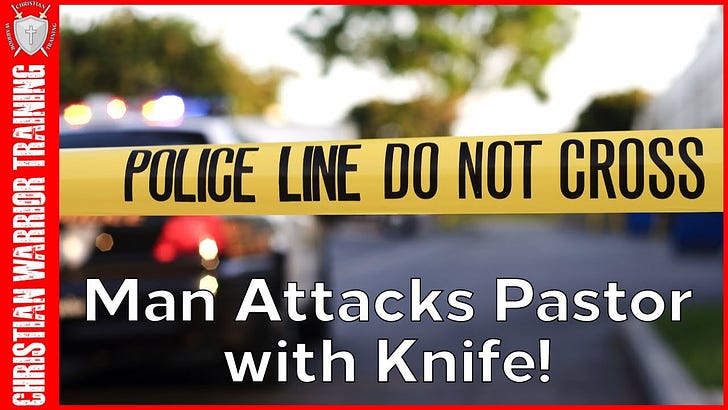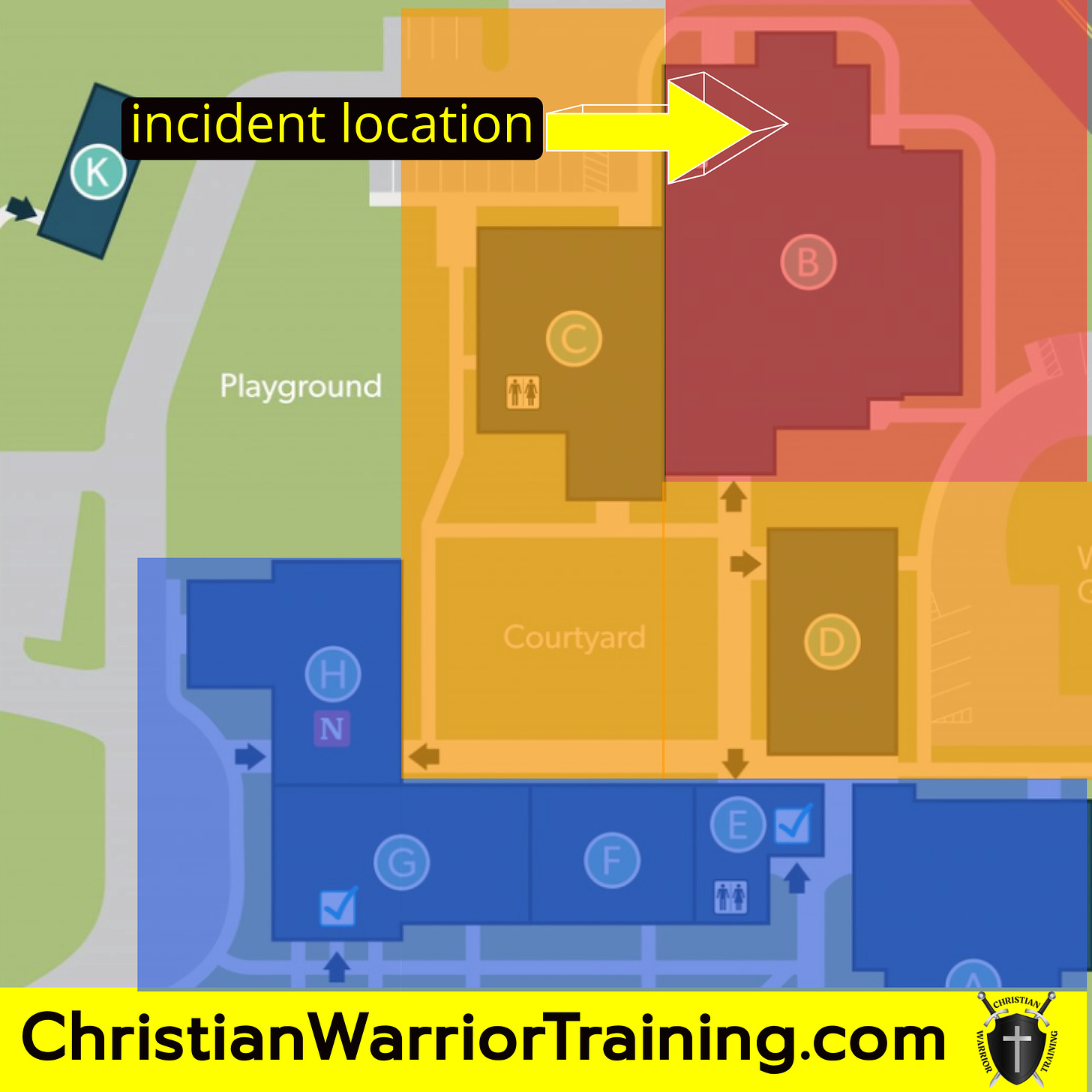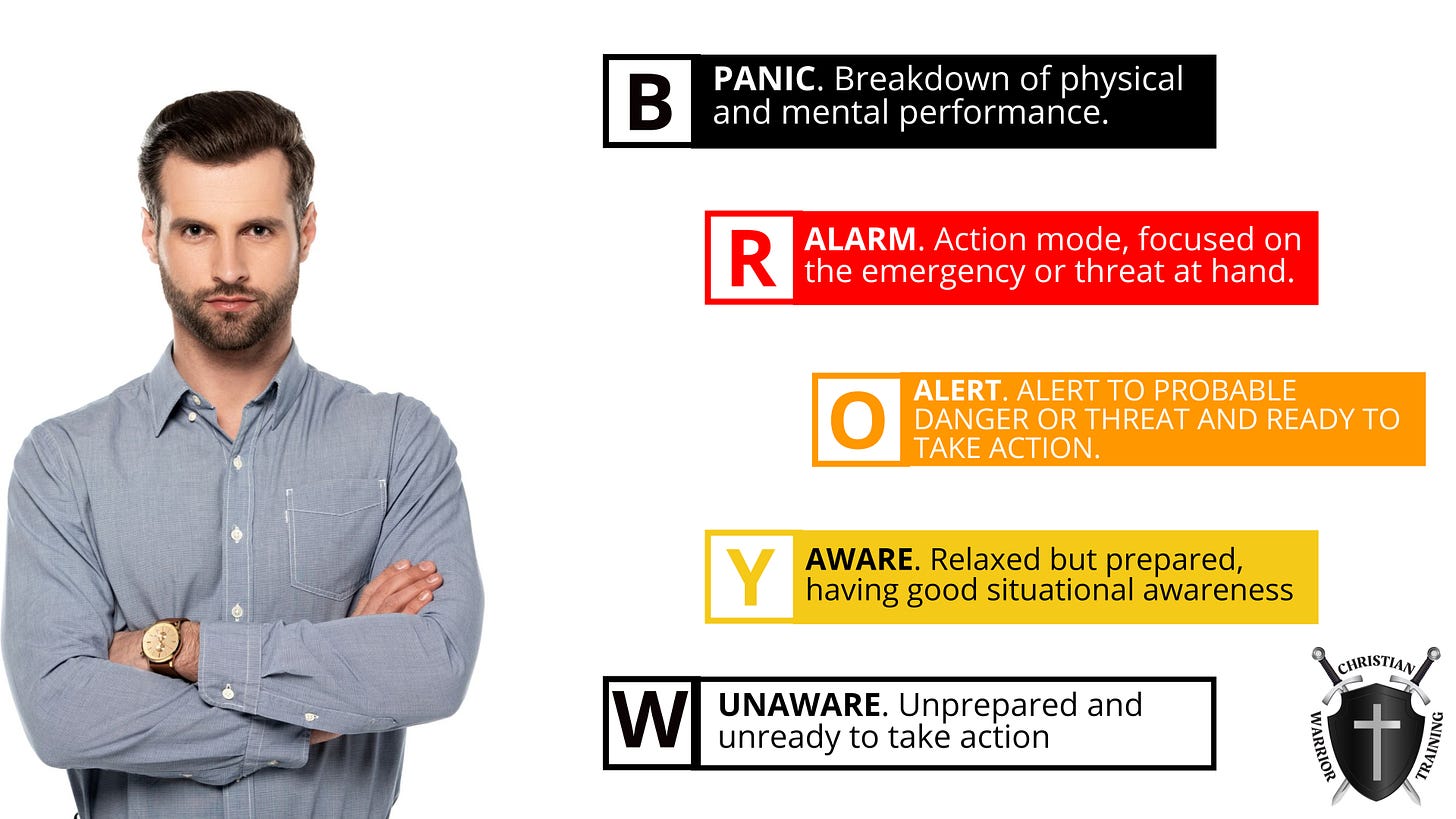In this article and accompanying video, we’ll be examining a real-life incident that took place during a church service in Carlsbad, California in 2021. The video has not been widely released publically. This debrief aims to provide a clear and factual analysis of what happened, offering valuable insights that can benefit church security teams across the nation. Our focus here is to identify both the strengths and areas for improvement observed in this situation, so that other churches can learn and prepare for similar scenarios.
The purpose of this debrief is not to criticize or second-guess the actions of any individuals or teams involved. Instead, we are here to study the event as a learning experience, acknowledging the challenges of managing security in a worship setting. It’s important to note the commendable openness of the church involved in sharing their experience with the Christian Warrior Training community. Their transparency reflects a commitment to improving safety measures in all faith-based environments, and it allows us to gain knowledge that could ultimately save lives.
By examining what went well and what could be done differently, we hope to equip other churches with actionable strategies to protect their congregations while maintaining a spirit of openness and faith.
Incident Overview
In December 2021, during a Sunday service at a church in Carlsbad, California, a disruptive individual created a tense and potentially dangerous situation that required immediate action from the church's safety team, pastoral staff, and local law enforcement. The suspect, who had a previous history with the church, entered the sanctuary displaying erratic behavior and was armed with a knife.
The church’s safety team was prepared, with four members who were licensed to carry concealed weapons present in the sanctuary. Three of these members were actively on duty, covering entry points and the sanctuary, while the fourth, who had served during the first service, was attending with his family. When the suspect’s behavior escalated, the team took up their positions, with one member initially drawing her weapon and issuing commands. The suspect was immediately confronted by both the safety team and multiple members of the congregation, who attempted to create barriers using available items like music stands.
However, the situation became increasingly complex as multiple individuals began engaging with the suspect. In an attempt to de-escalate, one of the pastors approached the suspect, physically interacting with him despite the visible tension and the suspect’s armed status. This interaction, while well-intentioned, posed additional risks, as the suspect exhibited several indicators of potential violence, including rapid breathing, a bladed stance, and aggressive body language.
After several minutes, local law enforcement arrived on the scene, quickly establishing a perimeter around the suspect. Officers requested that the pastoral staff step back to allow law enforcement to take control of the situation. Despite the inherent risks, the pastors continued to engage with the suspect, ultimately negotiating his peaceful surrender. Within ten minutes of the police arrival, the suspect surrendered without further incident and was taken into custody.
Following the incident, the church took measures to strengthen its security infrastructure, including the addition of cameras, a formalized security system, and medical equipment placed in strategic locations. Congregants, who were previously unaware of the church’s safety measures, expressed relief knowing that the church was taking steps to protect them. Despite these improvements, the incident highlighted the need for clearer protocols and alignment between the pastoral and safety teams, especially during high-stress situations involving immediate threats.
In the following sections, we’ll analyze this event in more detail, focusing on both the positive actions taken and areas where procedures could be refined. The goal of this analysis is to equip other churches with knowledge and strategies that can enhance their own security measures and support the safety of their congregations.
Analysis: Key Takeaways for Church Security Teams
Multiple Commands to the Suspect
When the suspect began displaying erratic and aggressive behavior, multiple individuals from both the congregation and safety team started giving him commands. This created a confusing environment that likely added to the suspect's disorientation, especially if he was experiencing mental health issues or drug impairment. In these situations, the human brain often struggles to process information from multiple sources, and this can quickly escalate an already tense situation.
To manage incidents like this more effectively, only one trained individual should be designated to communicate with the suspect. A single, calm voice is far more effective in reaching someone who may already be struggling to process information. By establishing a clear command voice, the safety team reduces the likelihood of misunderstandings or increased agitation on the part of the suspect.
Crowding the Suspect
During the incident, several individuals from the congregation and safety team began to surround the suspect. While the intent was likely to contain him, crowding an individual in this state can increase their sense of pressure, potentially pushing them toward aggressive action.
Maintaining a safe distance and reducing the number of people surrounding the suspect is essential. The presence of too many individuals nearby can create a feeling of entrapment, which may trigger an aggressive response. A small, controlled group with clearly defined roles—such as a single negotiator, a cover team member, and an evacuation manager—can handle the situation more effectively without escalating it.
Evacuating Non-Essential Individuals from the Area
In response to the unfolding incident, someone on the team wisely opened a side door, allowing congregants to exit. However, many people remained in the vicinity, moving from the immediate threat area (hot zone) into the adjacent area (warm zone) without reaching a fully secure space (cold zone).
In situations like this, it’s important to establish hot, warm, and cold zones to organize evacuation and control crowd movement:
Hot Zone: The immediate threat area where the suspect is located.
Warm Zone: An adjacent area with some risk but allowing for controlled evacuation.
Cold Zone: A safe area, ideally outside the building, far removed from the threat.
A designated individual—such as an extra security member, pastoral staff, or even a calm congregant—can be assigned to guide non-essential people from the hot zone all the way to the cold zone, ensuring they are fully removed from potential danger.
Maintaining Distance and Avoiding Physical Contact with Armed Suspects
During the incident, one of the pastors approached the suspect and physically engaged with him in an attempt to de-escalate. While this action came from a place of compassion, closing in on and touching an individual with a weapon posed a significant risk. For a suspect who might be mentally unstable or under the influence of drugs, physical contact can heighten agitation and lead to a violent response.
Best practices dictate maintaining a minimum distance of ten feet when engaging with an unarmed but erratic individual, and even greater distance when they are armed. Barriers should be used when possible to maintain safety. In these moments, it’s essential that pastoral staff and congregants trust the judgment of the trained safety team, allowing them to handle high-risk situations.
Recognizing Pre-Attack Indicators
The suspect displayed several pre-attack indicators, including rapid breathing, a bladed stance, a firm grip on the knife, and visible tension in his facial expression. These signs are commonly associated with an imminent attack and should prompt an immediate shift to high alert.
When multiple pre-attack indicators are present, the safety team should consider the situation as potentially lethal. Immediate actions, such as withdrawing non-essential individuals and preparing defensive measures, are warranted to protect everyone on the scene. Recognizing and responding to these signs can prevent sudden escalation and help the team stay one step ahead.
In a situation like this, deadly force is clearly allowed. Any reasonable person would believe they are about to be met by great bodily injury or death.
Managing Statements and Threats
At one point, the suspect openly stated that he was willing to die, which demonstrated a high level of commitment to his actions. It’s natural for people to want to minimize these threats by telling themselves, “he wouldn’t really do that.” However, such statements should always be taken seriously, especially when accompanied by pre-attack indicators.
In this case, the suspect’s verbal threats combined with his body language signaled a very real and imminent danger. Safety personnel should train to listen carefully to these statements and respond proactively, treating them as genuine expressions of intent.
Recognizing and Addressing Condition Black
During the incident, one of the pastors appeared to enter Condition Black—a state where a person is so overwhelmed by stress that they can no longer process information effectively. He began repeating the suspect’s name without giving clear direction, indicating that he was no longer capable of making strategic decisions.
Condition Black can compromise safety by impeding clear thinking, and in such cases, the safety team must recognize this and act. Physically moving the individual out of the scene, if necessary, and allowing trained team members to take control is essential. By doing so, the team maintains a functional chain of command, with responsibilities handled by those who are calm and fully alert.
Establishing Clear Incident Command and Negotiation Roles
During critical incidents, it’s essential to assign specific roles: one person communicates with the suspect, another stands ready for defensive action, a third individual focuses on evacuating non-essential people, and a fourth can coordinate with law enforcement upon their arrival.
Attempting to multitask in roles as vital as negotiation and incident command can lead to confusion and oversight. Clear, single-purpose roles ensure that each team member can concentrate on their responsibilities, creating a cohesive response and preventing overlapping efforts.
Analysis: Key Takeaways for Church Security Teams
Strengths of the Response
The safety team’s swift and decisive reaction to the threat demonstrated a solid baseline of preparedness. Upon recognizing the escalating situation, team members quickly positioned themselves to contain the suspect and protect the congregation. This proactive stance likely helped prevent immediate escalation and bought time until law enforcement arrived.
Congregants also showed presence of mind by creating barriers with available items like music stands. This quick thinking helped control the suspect’s movements, providing a buffer between him and other members of the congregation. Additionally, the spiritual support from the congregation, including members who turned to prayer, brought a calming influence in the middle of a tense situation. This spiritual grounding contributed to an atmosphere of resilience and collective calm, reinforcing the community’s bond in a challenging moment.
When law enforcement arrived, they efficiently set up a perimeter, coordinated with the church’s safety team, and managed to de-escalate the situation without resorting to force. The cooperation between the church and local police played a key role in resolving the incident peacefully, showcasing the benefits of a solid relationship with local law enforcement.
Areas for Improvement
While the response had many strengths, there are areas where protocols could be refined for even greater effectiveness in future incidents.
One area of improvement is in establishing a clearer command structure. In this incident, multiple people were engaging with the suspect simultaneously, which can create confusion and increase the risk of escalation. Designating a single command voice to interact with the suspect would help reduce his confusion, particularly in situations involving possible mental illness or drug impairment. A single, calm voice can provide clear direction without overwhelming the suspect.
Maintaining safe distances and using barriers when dealing with armed individuals is another critical aspect. The pastor’s decision to approach and physically engage with the armed suspect, though well-intentioned, posed significant risks. By maintaining a safer distance and allowing trained personnel to handle physical interactions, the church can better ensure everyone’s safety.
Finally, training in recognizing pre-attack indicators—such as heavy breathing, a bladed stance, or clenched fists—could enhance the team’s ability to anticipate and prevent escalation. Recognizing these signs early on can prompt appropriate responses that help manage the threat before it intensifies.
Lessons for Other Churches
Proactive Preparation
This incident underscores the importance of investing in proactive security measures, including effective communication tools, a structured evacuation plan, and defined roles for handling critical situations. Churches should prioritize regular training sessions to prepare safety teams, church staff, and even select congregants for emergencies. By establishing these protocols, churches can reduce response times, streamline actions, and foster confidence within the safety team and congregation.
Unified Response Strategy
Clear communication and a shared understanding of protocols between the pastoral staff and the security team are essential to avoid conflicting actions in a crisis. Both groups must be aligned on who takes charge during a threat and understand that, in such situations, safety team members may need to assume control temporarily. Establishing this shared protocol ensures that compassionate responses do not inadvertently compromise security.
Transparency on Security Measures
Churches often worry about creating an atmosphere of fear by discussing security openly. However, transparency can actually reassure congregants, as it communicates that their safety is being taken seriously. By openly sharing that the church has prepared security measures and trained personnel, congregants feel supported and more comfortable in their worship environment.
Closing Remarks
This analysis is provided not as criticism, but as a constructive learning tool for other churches. By examining both the strengths and areas for improvement in this incident, our goal is to equip other congregations with knowledge that can enhance their own security protocols. Special thanks go to the church in Carlsbad, CA, for allowing this experience to serve as an educational example for the broader community.
We encourage church leaders and safety teams to reflect on these lessons and incorporate them into their own security planning. By doing so, we can all work together to create safer environments for worship and fellowship.
Call to Action
To foster a community of learning, we invite readers and viewers to share their own experiences, insights, or questions. By exchanging ideas, we can support each other in building robust safety measures that align with our faith.
For those interested in further training, resources, or specialized workshops, visit the Christian Warrior Training platform, where we offer modules and guidance to help churches build effective safety teams and protocols.







Nothing better than an actual incident to learn from, especially when no one is injured / killed.
Church security teams should train their congregants, and pastoral staff, on their role during an incident, ie: calmly exit the area of confict. Period. There is nothing worse than too many cooks in the kitchen.
Thank you again for the video and your informed review and analysis.
Nathan